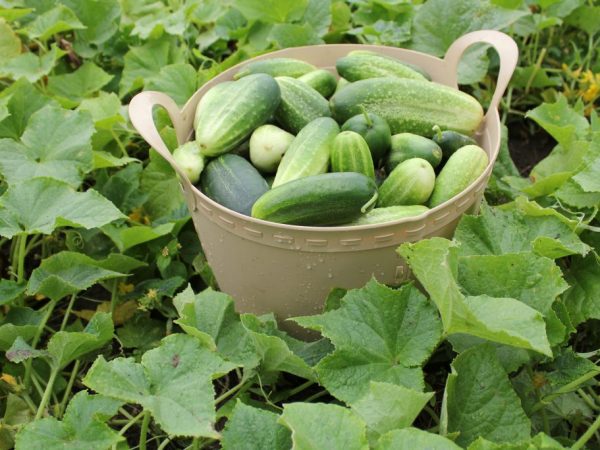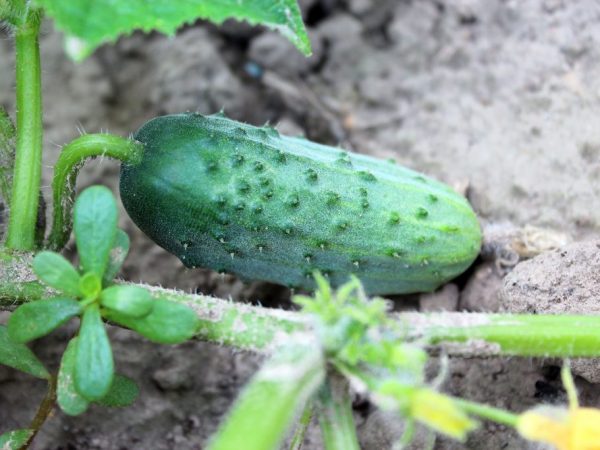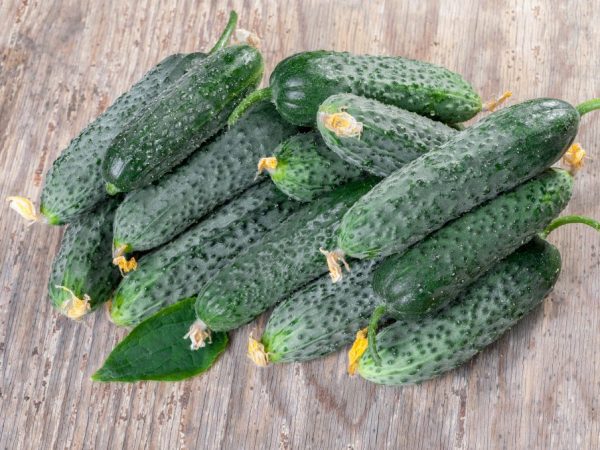The best varieties of cucumbers with the letter D
Vegetables occupy a significant place in the human diet, therefore, both professional farms and amateur gardeners are engaged in cultivation. Nowadays, many types of this culture are represented in retail chains. Consider the best varieties of cucumbers with the letter D.

The best varieties of cucumbers with the letter D
Medium early varieties
When growing early vegetables, the emphasis is often on the rate of ripening. However, the faster you harvest, the less aromatic the fruit will have. Cultures with medium periods have time to acquire all the necessary taste and market characteristics.
Understudy
An excellent plant for growing under polyethylene and outdoors. An undemanding bush is resistant to the most harmful ailments. A mid-early cucumber will delight you with the first harvest 7.5 weeks after the emergence of seedlings.
The Doubler hybrid, like the Druzhok F1 variety, is designed to produce gherkin-type fruits. "Universal" greens are covered with a thin skin with noticeable tubercles. The size of the products ranges from 8 to 11 cm, in weight - from 80 to 105 grams. At least 12 kg are removed from one bush.
Demarrage
The mid-season plant does not require pollinators and is cultivated in greenhouses. A tall liana with large leaves will delight the gardener with a bountiful harvest - from 30 kg per 1 m2. Like Danila F1, the variety is resistant to temperature extremes and low light. Resistant to powdery mildew and cladosporiosis.
Demarrage F1 is a salad cucumber that is devoid of specific bitterness. Pleasant sweetish pulp with rich aroma. Characteristic appearance of greenhouse fruits:
- elongated shape (over 18 cm);
- smooth skin;
- white "edge";
- green color of the coating.
Grandfather
The plant is classified as a mid-season species: 50 days pass from germination to the first harvest. The variety does not require pollination, therefore it develops well in indoor structures. Not afraid of the most dangerous diseases.
Like the popular hybrid Summer Ambassador, the Dedok cucumber has a bundle type of ovaries: 4 fruits are formed in one bosom. Small greens, reaching a length of 11 cm, have a pleasant, dense flesh. The products are intended for processing, they are also suitable for pickles, marinades.
Dasha our
The variety of the middle ripening period will delight with the harvest 7 weeks after germination. Does not require pollinators, therefore it is suitable for greenhouses. The plant is not afraid of temperature extremes and forms without problems in low light conditions, resistant to typical diseases.
Dasha Nasha F1 is juicy, dense cucumbers for universal use. The average length of zelents reaches 11 cm, and ripens in weight up to 120 g. With minimal care, 10 kilograms can be easily removed from a square meter of plantings.
Early varieties
The climatic features of the region do not always make it possible to get vegetables a month and a half after germination. Early vines are genetically adapted for rapid maturation.
Kindergarten
Ultra early grade. It does not require pollination, therefore it can be cultivated in greenhouses without any problems. High yield (from 13 to 27 kg per square) and long fruiting period make the hybrid a favorite among similar plants. Resistant to all dangerous fungi.
F1 Kindergarten, like Dragoon, is specialized for universal use. Small-tuberous gherkins in appearance resemble the popular Dvortsovy variety: they grow up to 9 cm in length, and in weight - no more than 85 grams. Pleasant sweetish pulp taste and excellent commercial characteristics.
Day
An interesting early plant that will delight with a bountiful harvest for a long period. Liana does not need pollinators, so it develops without problems in any type of soil. The bush is a shrub to the most dangerous cucumber sores.
Denek Hybrid is a tasty and aromatic vegetable specialized for universal consumption. Small gherkins are no more than ten centimeters long. At least 9 kg of products are removed from one square.
Dubrovsky

The bush grows well in any soil
A high-yielding variety that begins to bear fruit 40 days after germination. A medium-branchy vine does not need pollination, it will thrive in any type of soil. The culture is not afraid of fusarium and cladosporiosis, it is quite tolerant of downy mildew.
Cucumber Dubrovsky F1 is intended for universal use. Short greens with barely noticeable bumps and pleasant flesh. More than 12.5 kilograms of products are removed from one square, the average weight of a specimen is 120 g.
Dynamite
A successful plant of domestic breeding begins to yield at the sixth week. The tall parthenocarpic liana has a bundle-like ovary. With minimal care, at least 15 kg of products are removed from the planting square.
The Dynamite hybrid has delicious and beautiful cucumbers for universal use. According to the characteristics of Zelentsov, the variety is very similar to the popular Justina. The length of the fruit reaches 12 cm, and when ripe, the weight ranges from 110-130 grams.
Kids on a branch
An early ripe vegetable gives its first harvest in 42 days. Does not require pollinators, therefore it grows well in all types of soil. Three ovaries are formed at the nodes of the spreading liana. The bush is not afraid of common diseases.
Hybrid Babies on a branch, like the Thumbelina F1 variety, are small (up to 100 g) cucumbers, without bitterness. The homogeneous pulp without voids has excellent taste characteristics. The use of fruits is universal.
Uncle Styopa
A popular early vegetable specialized for greenhouse cultivation. A long and plentiful harvest occurs in the seventh week after sprouting. A medium-branched bush with bunched ovaries with minimal maintenance will allow you to remove 13 kg from a square of plantings. Resistant to common diseases and temperature fluctuations.
The Uncle Stepa hybrid has neat greens of the same shape. The cucumbers are covered with a smooth skin with noticeable bumps. Juicy pulp without voids and bitterness is perfect for fresh consumption.
Ladies' man
An early plant that does not need pollination. In terms of characteristics, it resembles the Uncle Stepa variety: a high-yielding bush with bundle ovaries begins to bear fruit in the seventh week. Not afraid of cucumber diseases, unpretentious in cultivation.
The Lady's Man hybrid will delight the farmer with beautiful and neat cucumbers. Zelentsy has a very fragrant pulp and thin skin. During transportation and storage, the products retain their commercial characteristics for a long time.
Wonderful miracle
A popular plant for greenhouse and outdoor cultivation. A tall bush enters the fruiting period at 45 days, allowing you to remove up to 10 kg of greens from each square.Undemanding to care and not afraid of common fungal diseases.
You can recognize the Marvelous hybrid by the appearance of the fruit Cucumbers are similar to the time-tested Moscow delicacy F1: small (up to 11 cm in length) gherkins are covered with a thin skin with very small tubercles - "thorns". Fragrant pulp without bitterness and voids is used fresh and canned.
Papa's daughter
A fertile plant enters the yield period on the 43rd day. It develops without problems under the film and in the open field. Like the variety Ladies' whim, it forms several bundles-ovaries in the axils. It is not afraid of common cucumber diseases and is quite shade-tolerant.
Papenkin's daughter is neat, spindle-like greens, reaching a length of 14 cm. Thanks to the unique selection work, the products have no bitterness and voids in the pulp. Excellent taste and market characteristics, specialized for universal use.
Brownie

The fruits are versatile in use
Often the plant is confused with the indoor cultivar Brownie Kuzya. Unlike the potted variety, the professional vine has a sturdy, spreading bush. The culture forms bundles-ovaries and will delight the farmer with a long, abundant harvest and the presence of strong immunity.
Brownie hybrid can be recognized by neat cucumbers of the same shape. Zelentsy are covered with a dark skin with large tubercles, they grow in length up to 13 cm. Pleasant pulp without bitterness and voids allows you to use the product in any form.
Bee-pollinated varieties
Many gardeners choose to grow parthenocarpic plants. However, a bountiful harvest can be obtained only with the help of insects. In addition, such a culture has maximum resistance to typical diseases.
Noble
The mid-early hybrid is specialized for outdoor development. The unpretentious tall bush has a strong immunity to olive spot. With minimal care, 20 kg of products are removed from one square meter of plantings.
Noble F1 - this is a medium green, covered with a thin peel with small tubercles. The mass of gherkins reaches 95 grams, they do not turn yellow. Delicate aroma and juicy flesh allow fresh and processed fruits to be used.
Village fair
Another successful bee-pollinated hybrid, which is specialized for growing under film. It enters the yield period after 7 weeks, and at least 13 kg is removed from one square. The branchy plant is unpretentious in cultivation and is not afraid of typical diseases.
The cucumber Village Fair has beautiful small fruits, covered with a thin skin with small pimples. Possesses excellent gustatory and commercial characteristics. Gherkins are intended for use in salads and canned food.
Foreign selection
We recommend that you pay attention to the sotra bred by foreign breeders to obtain the highest possible yield.
Dolomite
An amazing plant appeared on the Russian market in 2010, but it still does not lose its relevance. The ultra-early cucumber will delight you with the first harvest 38 days after germination. The bush does not need pollination, it develops well in any soil conditions. It is not afraid of common fungal diseases and quickly recovers from care errors.
The Dolomite cucumber is a small gherkin (up to 12 cm in length) that can be harvested at the pickle stage. The hybrid is universal, but the best characteristics are manifested in a redesigned form. At least 6 kg of products are removed from one square.
Thin rind and dense pulp, which does not lose its crispness after processing, provides a unique taste of the finished product.
Delicacy white
We recommend paying attention to an unusual plant of Chinese breeding. The high-yielding early bush develops without problems under the film and in the open air.The culture has a strong immunity to dangerous diseases, is not afraid of temperature changes and mistakes in care.
Delicacy white F1 is a hybrid that stands out from its peers. The original fruits are covered with an unusual skin, which makes the greens look like exotic fruits. Otherwise, its characteristics resemble the popular Dutch Dolomite. It grows in length to about 12 cm, universal use.
Desdemona
A high-yielding plant of Czech selection belongs to the mid-early varieties. From the beginning of mass shoots to the fruiting period, 50 days pass. Like the Dutch F1 Dolomite, the bush develops in all types of soil and is not afraid of dangerous diseases.
Desdemona's hybrid is designed to produce gherkins and pickles. Miniature cucumbers do not outgrow or turn yellow. The aromatic sweetish pulp will reveal its taste characteristics both in the salad and in the processed form.
Delpina
An early bee-pollinated variety of German selection has recently begun to gain the interest of domestic farmers. Strong and productive, it will delight you with maximum returns throughout the growing period. Not afraid of high temperatures and unpretentious in cultivation.
Delpina F1 is a delicious and aromatic gherkin type greens. Short cucumbers grow on average up to 10 cm in length, and their weight does not exceed 95 grams. At least 3.5 kg of products suitable for universal use are removed from one bush.
If you understand the range of varieties, then the cultivation of cucumbers will become much easier. In our recommendations, only the most popular hybrids are considered with a detailed description of the characteristics.


